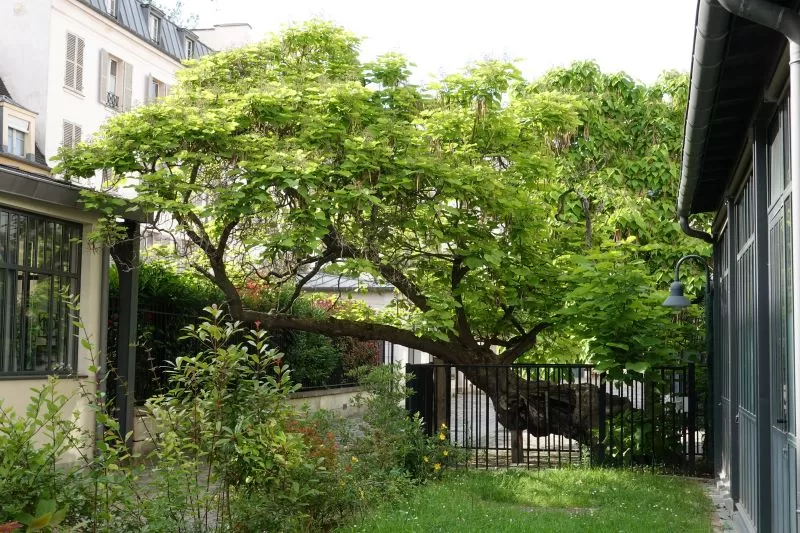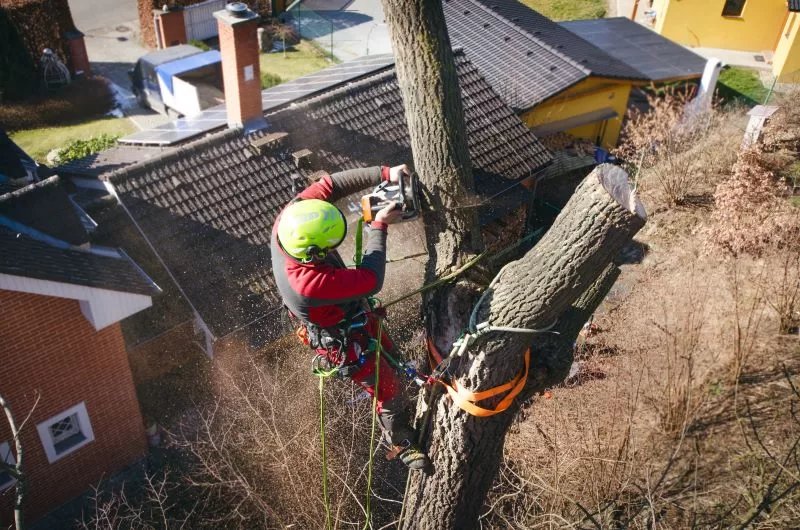Who doesn’t enjoy the view of lovely trees gently swaying in the wind? Yes, they’re undeniably beautiful, and they hold sentimental value. In fact, one survey found that 16% of people feel closer to their trees than their neighbors. That’s nearly double the 7% who said the other way around. (1)
Some trees survive for generations and become a special part of a family’s history. But sometimes, that towering pine or charming oak turns out to be a liability rather than an asset that calls for tree removal. If you’re unsure whether a tree in your yard is still safe, keep reading this piece.
Here are some clear signs that tree removal may be the best option.
1. Tree Has Large Dead Branches
A few dead branches here and there aren’t usually a big deal or cause a concern. It’s just a natural part of a tree’s growth cycle. But if you take a look at its crown, that’s another story. Does it have vibrant foliage and flexible limbs? If yes, then it’s a healthy tree.
However, if you see bare branches or large sections of deadwood, then it’s a red flag. There’s something wrong with the tree, either struggling with a disease or dealing with a pest infestation. And this can become a safety hazard to people, pets, and nearby structures, as they can snap off anytime.
A tree removal specialist can assess the situation and check for structural failure. If the tree can be saved, pruning or other treatments may help restore its health. But if it’s too far gone, taking it down might be the safest thing to do.
2. Trunk Shows Visible Damage
The trunk is basically the base of a tree. It has to be solid and stable to keep it from collapsing. When that support system begins to wither, the entire tree becomes at risk. Signs of trouble may include deep cracks, hollow spots, or areas of decay.
Large wounds from harsh weather, improper pruning, or old age can speed up this decline. As the damage progresses, fungi may start appearing on the bark, often indicating there’s an internal rot.
At this point, the tree’s stability is in question. To be sure, tree removal is likely the wisest decision. Of course, a weakened trunk might not be able to hold the weight of heavy branches, which just raises the risk of accidents.
3. Sudden Leaning or Unstable Growth Pattern
Some trees grow at slight angles, and that’s perfectly normal. However, you can consider it a problem if the tree suddenly bends or keeps leaning more. This is especially concerning if the roots lift from the ground, which signals potential instability.
To compensate for a lean, trees develop reaction wood—extra tissue on one side of branches or trunks that helps them resist gravity. While this adaptation can offer temporary support, it doesn’t fix deeper structural problems. (2)
If the lean keeps getting worse despite these natural adjustments, it could be at risk of falling. And that’s when it becomes a hazardous tree that could cause property damage.
4. Severely Damaged in a Storm
Does your area frequently experience strong winds, heavy snow, or intense thunderstorms? Extreme weather can be damaging to trees. While some might lose a few branches or twigs and recover, others may incur extensive damage that the tree won’t survive, even with professional care.
If a storm has left a tree in bad condition, it’s ideal to have it inspected by a tree care expert as soon as possible. They can determine whether the tree can be saved or if removal is necessary.
5. Location Is Causing Property Conflicts
Sometimes, a tree isn’t in the right spot. Perhaps it’s too close to your house, it’s blocking sunlight, or the limbs are scraping against the roof. In other situations, roots crack driveways or interfere with underground plumbing systems.
Then there’s the issue of power lines, which can pose a fire hazard or cause outages during storms. If a tree is consistently being a nuisance, it might be time to remove it before it leads to bigger and more costly problems.
6. The Tree is an Invasive Species
According to research, invasive plants are responsible for the decline of over 42% of threatened and endangered species in the U.S. This impact isn’t limited to forests and wildlands. It can also happen in your backyards. (3)
An invasive tree, like Norway Maple or Tree of Heaven, might seem harmless at first, but it won’t stay that way for long. Its roots can creep into garden beds and steal water and nutrients from other plants. Some kinds even release chemicals into the soil that stop other plants from growing.
Over time, these trees can spread fast, overwhelm native ones, and throw off the natural balance of the landscape. Before it’s too late, taking it down could be the best way to protect the rest of your yard.
7. Plan To Renovate the Property
Your tree is in good shape, but it’s standing right next to where your new patio or home addition is supposed to go. Even if you want to keep it, construction can put a lot of stress on the tree. Between heavy machinery and digging, its roots might get damaged.
If a renovation will compromise a tree’s health or stability, it’s worth considering removal before the project begins. This avoids unexpected problems in the future and gives you a chance to redesign the space with a fresh start.
Wrapping Up
Trees add so much to your surroundings, but removing one becomes the safest choice for everyone involved.
Regular inspection and early intervention can prevent many tree problems from reaching crisis levels. Always trust your observations and professional guidance. And while it’s never easy to part with your beloved tree, it can make way for new growth and a healthier landscape.
References
1. “People love their trees more than their neighbors, says survey”, Source: https://phys.org/news/2023-08-people-trees-neighbors-survey.html
2. “Adaptations”, Source: https://www.britannica.com/plant/tree/Adaptations#ref368858
3. “Invasive Plants”, Source: https://www.fs.usda.gov/wildflowers/invasives/index.shtml


